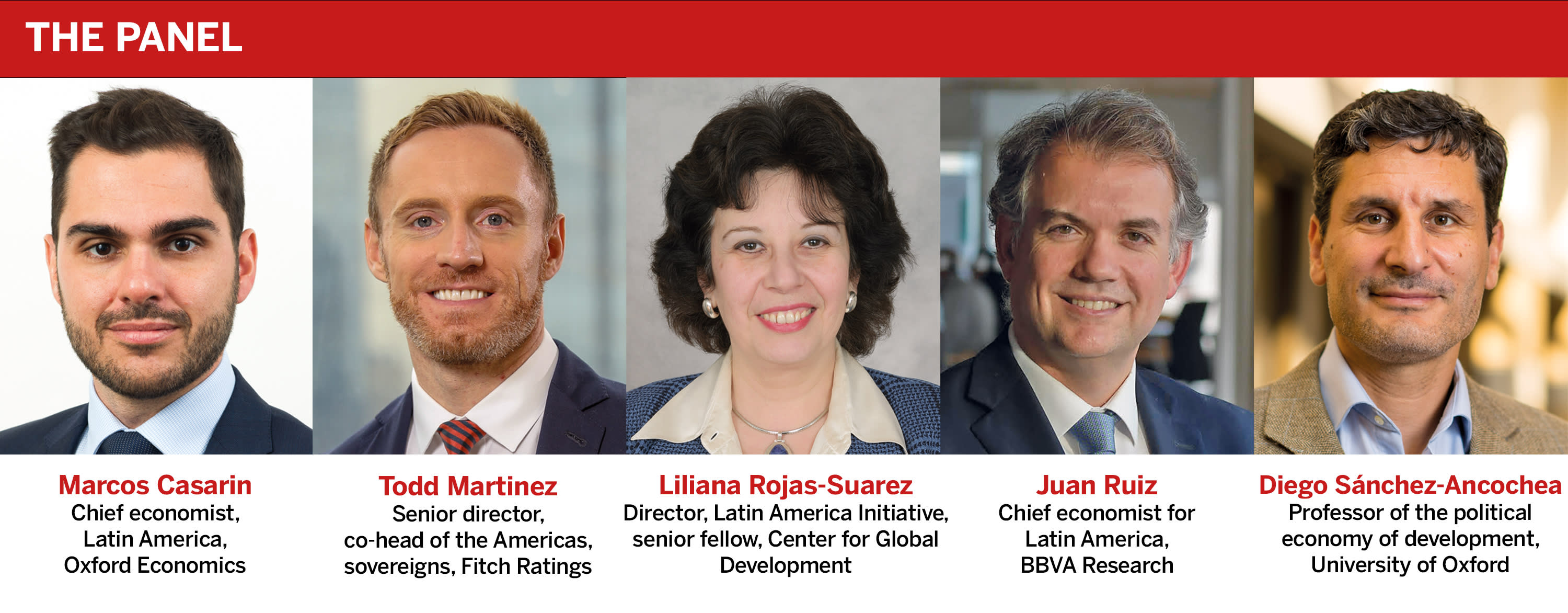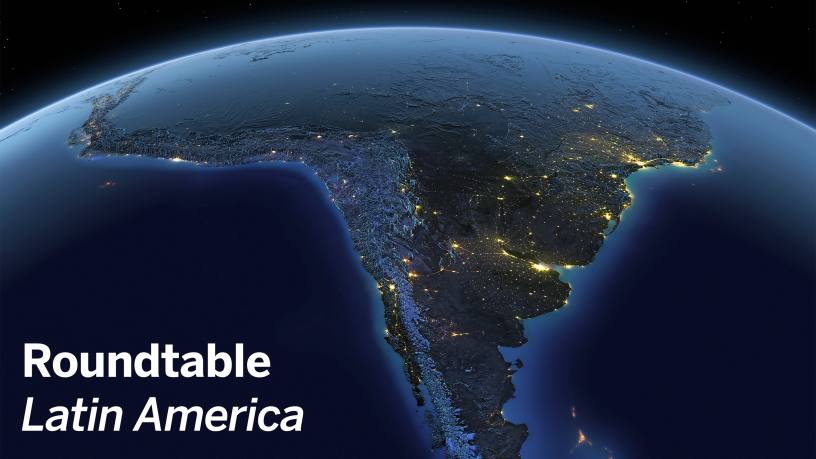
- What are the main economic challenges for Latin America (Latam) and the Caribbean in 2023?
Diego Sánchez-Ancochea: According to the Economic Commission for Latin America and the Caribbean, the region grew by only 3.7% in 2022 and economic growth will further decrease in 2023 to 1.3%. This deceleration takes place after a lost decade in which gross domestic product [GDP] per capita went down in real terms due to the pandemic and other global shocks. Low economic growth combined with high inflation and interest rates will make policy management particularly difficult. Countries will face growing demands to increase social programmes and reduce poverty and inequality, but will have to deal with limited fiscal space. A steady increase in commodity prices driven by higher economic activity in China would make things slightly easier for commodity-exporting countries, while worsening conditions further in Central America.
Todd Martinez: Latam came through 2022 better than expected, but a weakening in economic indicators at the end of the year suggest a challenging 2023. Hopes are growing for a ‘soft landing’ in the US, a stronger rebound in China amid its economic re-opening, and a better-than-expected energy situation in Europe. But we still expect a substantial global slump, and any positive surprises could be a mixed blessing for Latam, particularly should this add to inflation pressures and reinforce tight monetary policy. Political uncertainty could impose a drag, particularly in Andean countries. Thankfully, external borrowing conditions have improved a lot for most of the countries.
The region needs to engage in comprehensive growth-enhancing reforms to improve productivity
Marcos Casarin: The bigger economies (Brazil, Mexico, Argentina, Colombia, Chile and Peru) are still very much focused on the job of bringing inflation down, while some smaller ones (such as Bolivia and El Salvador) have started the year flirting with a balance of payments crisis. Argentina has been in a balance of payments crisis for a few years for that matter. A common challenge across the region is the imbalance between what voters want governments to do (in terms of social policy and reforming institutions) and what governments can effectively deliver.
Liliana Rojas-Suarez: A key challenge for Latam and the Caribbean in 2023 is to reignite its motors of growth. First, this growth slowdown is happening at a time when commodity prices are still quite high and many countries in the region should be benefiting from this positive terms-of-trade shock. Second, growth underperformance has characterised the region for almost a decade now. The region needs to engage in comprehensive growth-enhancing reforms to improve productivity. Some of the most pressing areas for action include institutional reforms to improve adherence to the rule of law and enforcement of contracts, as well as public sector reforms to improve managerial capabilities at the subnational levels.
Juan Ruiz: The region is now facing a tightening of global financial conditions, which will represent significant headwinds directly and also through its effect on lower global demand and lower commodity prices. Countries with sound policy frameworks will be more able to continue tapping international financing, but countries with significant fiscal and/or external imbalances, and with weak fiscal and monetary frameworks, will be forced to make significant adjustments.
- The Covid-19 crisis has been an unexpected exogenous shock to countries across the region. How much is the region likely to face debt sustainability problems?
Mr Ruiz: Most countries in the region have solid monetary and fiscal policy frameworks and should be able to manage public finances to reabsorb the fiscal impulse (rightly) implemented during the pandemic. Rising borrowing costs will further weaken public finances in the region. Debt levels are still sustainable in most countries in Latam, but for sure there are a few countries that will be distressed amid tighter global financial conditions. Fortunately, it is not a region-wide problem.
Mr Martinez: Covid-19 was a severe hit to public finances in Latam, yet it didn’t seem to fuel debt sustainability problems that weren’t there already. Most countries saw much faster-than-expected fiscal recoveries in 2021 and 2022. Fiscal challenges could grow in 2023 due pressure for social spending and subsidies, inflation, slower economic growth and higher borrowing costs. But we still expect stable or only gradually rising debt/GDP for most countries in the region, and we even expect meaningful debt reduction in the Caribbean (Jamaica, Aruba, Barbados) and Costa Rica.
Mr Sánchez-Ancochea: Variance in debt burdens across the region is high. Central government debt amounts to 103% of GDP in Argentina and 89% in Brazil, compared with 32% in Chile or 29% in Guatemala. Yet there is no doubt that the Covid-19 pandemic led to increasing deficits in all countries. We should not separate debt sustainability issues from the region’s social challenges. High debt in the context of unmet social demands and insufficient human development makes things particularly problematic. If countries like Brazil expand their deficit further, they could confront a debt crisis, but if they do not expand redistributive programmes, they will likely face a social crisis. More attention to tax reform may be the only way to square the circle.
Ms Rojas-Suarez: Most countries have maintained a commitment to macroeconomic stability, even if economic growth remains elusive. Although both governments and corporates took on significantly more debt during the Covid-19 period, many governments have initiated efforts to correct their fiscal imbalances and prevent debt ratios from deteriorating further. Central banks’ large accumulations of international reserves, mostly in US dollars, gives confidence to investors that countries have the necessary liquidity to service their outstanding liabilities. Of course, the disconnect between macro stability and growth cannot last forever. If debt ratios remain high and growth remains anaemic, eventually the capacity to service obligations will be compromised.
Mr Casarin: The good news is that the bigger economies in Latam, except for Argentina, all have moved from borrowing in dollars to borrowing in their local currencies, which makes their debt more sustainable. In the smaller ones, though, we are almost certain to be headed to some sort of event in Bolivia and El Salvador, which don’t have sufficient reserves or market access to face their dollar-denominated debt repayments. And Argentina, of course, also needs a more permanent solution, which will probably happen after this year's election.
- Latam is the most unequal region in the world. Has the situation changed following the Covid-19 pandemic?
Mr Casarin: Income inequality certainly increased during the pandemic, because highly skilled professionals were able to preserve their income by working remotely, whereas those employed in low-paid services couldn’t.
Mr Ruiz: Despite public support programmes, the economic impact of the pandemic hit the most vulnerable hardest: women, the informal sector, the smaller firms and those self-employed, those without access to credit, and, especially, those with poor or limited access to health services. Covid-19 increased poverty and inequality in Latam and, despite having recovered some of those losses in 2021 and 2022, we still have lost eight to 10 years of recent advances in reducing poverty and inequality in the region.
Mr Martinez: A surprisingly strong surge in remittance inflows from the US has helped mitigate the impact for Central America, yet this has not greatly improved the issues driving major emigration from the region. Governments are under pressure to address social inequities via increased social spending and other reforms, but given narrower fiscal space and lacklustre growth prospects throughout the region, these efforts will need to be carefully calibrated.
Mr Sánchez-Ancochea: Income distribution improved across the region in the 2000s thanks to a combination of high economic growth, labour market policies and anti-poverty programmes. Yet the reduction of inequality stagnated after 2015. The pandemic also contributed to an education crisis with very negative long-term consequences on inequality. Inequality in Latam is primarily driven by the concentration of income among the very wealthy. As such, any tax reform effort should consider how to increase direct taxes on high-income groups.
Ms Rojas-Suarez: Unfortunately, the evidence suggests that Latam will remain the most unequal region in the world for the foreseeable future. The pandemic triggered a rise in labour and firms’ informality. In some countries, like Bolivia and Peru, informality has now reached more than 70% of employed workers and ratios above 50% are common in other countries. Informal jobs are largely low-quality, with low levels of productivity and low wages, which exacerbate income inequality.
- There have been shifting paradigms in Latam’s economic development. Where do you think we are at the moment?
Ms Rojas-Suarez: Latam’s economic development paradigm is at a crossroads. In recent years, an increasingly vocal set of people have questioned the benefits of the market-oriented model that has, loosely, guided policy actions in the region since the 1990s. Part of the discontent is dissatisfaction with social protection schemes such as private pension plans, but frustration is also directed toward the provision of other social needs, such as education and health services. These discontents have manifested in an increasing political polarisation. Interestingly, however, in most countries populations across the political spectrum agree on the need to maintain macroeconomic stability. Few question the role of central banks in reducing inflation or the need to avoid debt defaults; the painful experience of the 1980s has cemented those beliefs. Whether the region will experience a permanent shift in its development paradigm is an open question.
Mr Martinez: A “pink tide” has ushered in leftist governments in most of the region’s major countries. But this has reflected anti-incumbent sentiment more than support for a radical economic paradigm shift and thus far it has affected microeconomic policies more than macroeconomic policies. Andrés Manuel López Obrador [Mexico] has preserved conservative fiscal settings, while Gabriel Boric [Chile], Gustavo Petro [Colombia] and Luiz Inácio Lula da Silva [Brazil] pledge responsibility and have sought to fund spending initiatives with tax reforms. And they have largely respected the autonomy of their central banks. But they have articulated a more obvious micro-policy shift favouring greater state involvement, while initiatives to improve productivity and private sector prospects have been scant. This has already manifested in interventionism in Mexico and is a source of uncertainty in the others. We don’t expect economic instability in the region, but see inauspicious signs for improvement in muted growth prospects.
there is growing agreement in the region about the goals of economic policy but less so about the means to achieve them
Mr Sánchez-Ancochea: Despite political polarisation, there is growing agreement in the region about the goals of economic policy but less so about the means to achieve them. Let me give three examples. First, the importance of securing macro-stability is recognised across the board. Yet while too many mainstream economists emphasise the need to cut public spending, others call for higher direct taxes. Second, there is a growing consensus about the need to exploit natural resources in a more sustainable way and to add more value to the region’s exports. Yet can pro-market policies alone achieve these objectives or do we need a more active industrial policy? Third, in the area of inequality we also see the consensus in goals but not in aims.
Mr Ruiz: In most countries of the region, we continue to see markets and integration into the world economy at the centre of development. This paradigm replaced the previous one, based on state-led industrialisation, which included, but went beyond, industrialisation by import substitution. On the one hand, it is true that markets function better than in the 1970s in providing signals for consumption and investment decisions, but the region still has to ensure that there is more competition in goods and services markets, and more flexibility in factor markets, especially in the labour market. Regarding integration into the global economy, countries on the Pacific coast have opened up to global trade, but Mercosur countries [the customs union between Brazil, Argentina, Uruguay and Paraguay] lag significantly behind. Latam is lagging behind regional economic integration.
Mr Casarin: We see Latam very much stuck in the middle income trap. There has been a huge gain in prosperity, with productivity catching up fast with that of advanced economies during the 2000s commodity supercycle. However, since 2014 most of the ground was lost with relative productivity falling massively compared with that of the US. In the long term, there is hope that Latin Americans’ living standards improve off the back of investments in clean energy and in productive capacity.
- We often talk about the region as a whole despite the differences across the region. Which policy or economic challenge would you highlight that is specific to any of these countries?
Mr Ruiz: The region is heterogeneous but shares many common challenges: poverty, inequality, high informality, low quality of public services and promoting the rule of law. One opportunity is how best to take advantage of the nearshoring process. Mexico is very well placed to take advantage of this, but it needs to provide the proper signals that the institutional risk for potential investors is low.
Mr Sánchez-Ancochea: The debt position is very different across the region. It is always surprising to hear some Guatemalan policy-makers call for lower public spending and more austerity when their debt burden is so low. By contrast, other countries face a real and urgent fiscal challenge. Another important difference has to do with the contribution of commodity exports. We always think about Latam as a region rich in mining and oil, but this is not the case across the board. Any increase in oil prices, for example, will have asymmetric effects across the region, making things harder in Central America but much easier in Venezuela or Ecuador.
Mr Martinez: The largest countries – Brazil, Mexico, Colombia, Chile, Peru – have fairly solid macroeconomic frameworks that should help them navigate an uncertain backdrop. But these have been tested in some cases (for example by fiscal risks and early pension withdrawals) and efforts will be needed to preserve their strength. Furthermore, their growth prospects appear lacklustre, given reform agendas more focused on social grievances than productivity and political uncertainties in some cases (namely Peru). Policy discipline has anchored favourable market access for many smaller economies (Paraguay, Guatemala, the Dominican Republic), but efforts to advance financial and institutional development are needed to enhance their resilience and strength. And countries without strong liquidity, flexible currencies and affordable market access (Argentina, Bolivia, El Salvador) face the highest vulnerability and need credible policy adjustment plans to overcome this.
Mr Casarin: First, Argentina needs to sort out its balance of payments problem. No one has confidence in the peso and a joint currency with Brazil is not the answer. Brazil, on the other hand, has solid external accounts but very fragile public finances, so reforming the tax code and cutting unproductive spending are top of the list. Mexico should stop ignoring climate change and reverse the measures that discouraged investment in clean energy. And those smaller economies that rely on dollar-denominated debt, should probably embrace International Monetary Fund (IMF) support sooner rather than later.
Ms Rojas-Suarez: In Argentina, macroeconomic mismanagement has been the rule for most of the country’s recent history. Argentina’s multiple programmes with the IMF do not seem to have solved this problem. Venezuela is a failed state where an autocratic government has produced hyperinflation, a huge increase in poverty leading to massive exodus of people from the country and sustained violations of human rights. In Argentina, the upcoming presidential elections this year brings hope.













